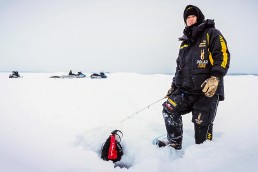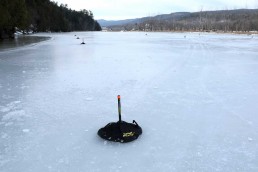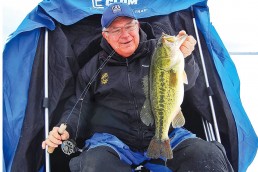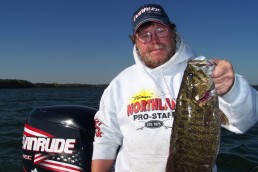Tip-ups and Deadsticks Tempt and Trigger Tentative Fish
SHARE THIS POST
In today’s modern, “run-and-gun” world of ice fishing, strong emphasis is often placed on using an active or mobile approach, featuring jigging as the central focus of the game plan. And for good reason—given the right combination of environment, situation, species and conditions, this strategy has proven deadly.
However, I find it interesting that even the most die-hard run-and-gun jigging advocates clearly understand the advantages of a more idle approach. While they may not freely admit it, they often reveal this recognition by drilling secondary holes occupied by what’s fondly referred to as a “sitter pole” or “deadstick” system.
They’ve found that an actively jigged presentation can be effectively implemented to draw attention, lure fish in and trigger responses from more aggressive feeding fish. But, also, should any pass on the active presentation, will often respond by taking the nearly motionless stand-by set in close proximity. This “sitter line” also provides an opportunity to tempt less decisive, but curious fish and provide them something to mull over on their own time and terms, without being spooked.
Whatever the reason, the combination has often proven effective.
This is why I find it so ironic that more anglers don’t bother to set tip-ups. Granted, this strategy involves hauling more gear onto the ice and a little more setup time—and not everyone enjoys the “hand-over-hand” method. Yet tip-ups provide some distinct benefits, and those not using them are not only missing out on some overlooked action, but some serious fun.
‘Run-and-gun’ vs. ‘Sit-and-wait’
All too often, ice anglers think the sport of ice fishing consists of essentially two contrasting approaches: the “run-and-gun” or “sit-and-wait.”
And I can understand why.
There are times when a highly mobile approach involving aggressive hole drilling is not only effective, but also necessary, such as when following a tight, roaming school randomly cruising a mud flat. In such situations, there’s no question the advantages of this fast-moving approach have been well documented.
However, given the accuracy of electronic charts, mapping and GPS systems, careful preplanning makes focusing on specific targets much easier, reducing the necessity for drilling so many holes and allowing a much quieter, less invasive approach. In fact, knowledgeable anglers fishing during the right conditions and strategically situated over proven locations or “necked-down” migration routes, have proven this method not only effective, but also at times superior to high-speed chases.
Since I’ve seen both strategies work, I’ve determined that unless the situation has historically proven one approach dominantly superior to the other, the best solution is typically a compromise.
Depending how many lines you’re legally allowed, you can drill a predetermined grid of holes over a target area, with the outer holes strategically positioned to accommodate a spread of tip-ups surrounding the area you’ll be jigging (and a combination approach you’ll find speeds and recognition of viable patterns).
How? By effectively covering a much larger area, you’re not only placing presentations in front of more fish, but keeping track of the lines intercepting fish, helping monitor movements too. In other words, you can use this system to key in on subtle shifts that might otherwise be difficult to recognize by simply jigging.
The trick is to continually fine-tune your position. Here in Wisconsin, where we’re allowed three lines, I typically begin by jigging one hole, placing a deadstick system nearby and a tip-up farther away, while the others in my group do the same. When exploring obvious structures—a large, mid-lake point—our group might start out by spreading a few holes in a line along the top of the primary drop-off and continue by following with more holes staggered along the edge of the break and extending out toward the base before continuing across adjacent saddles or high over an adjoining deep basin.
Are you enjoying this post?
You can be among the first to get the latest info on where to go, what to use and how to use it!
As we explore the drop in more detail while jigging, we’ll monitor tip-ups positioned along the top of the break and over deeper water. And, working together, we’ll hone in on productive secondary structural features and details. We’re trying to determine spots and depths where fish are concentrating, and if possible, identify probable migration routes between them.
This is accomplished by realigning our tip-ups as we jig to better cover and expose secondary features and any adjoining inside turns, fingers, bars or extensions leading from the point toward deeper water. We will stagger the distance that our presentations are positioned off the bottom. This results in a more thorough means of covering prime water, making our efforts more efficient and easier to narrow down not only the most productive locations, but also the distance, depth and timing of any fish movements. Sure, you can accomplish this while jigging, but with the additional lines, it’s possible to gain more information faster, meaning you can lock onto working patterns with greater efficiency.
This is especially important when subtle changes in fish positioning or movements occur, because dynamic pattern details are often revealed by simply noting shifts in activity throughout your spread, and comparing the combinations of features and characteristics available where these active lines are positioned.
Another significant advantage of tip-ups is they can be set at a distance from where you’re jigging. There’s minimal disturbance around these holes. Also, this is a definite benefit when fishing very clear or shallow water with easily-spooked species like crappies, trout, or walleyes, especially during sensitive times with first ice when ice cover is minimal and there’s little or no snow cover producing more overhead noise and fish-spooking shadows and movements.
Furthermore, the right tip-up models that are set correctly offer very little, if any, resistance to light-biting fish. Trip tension on HT’s Polar Pop-Up magnetic for example, is set using magnetic tension between magnets located on the spool and the spring-loaded flag signal. The spool position is adjustable, meaning you can slide the spool up or down, in turn placing these magnets in closer proximity for an increasingly “stronger” setting—or gradually spreading them farther apart for lighter ones, to the point where the tension is so slight the magnets barely hold the signal flag down. You can’t get much lighter than that.
Incidentally, standard underwater tip-ups like HT’s classic Polar can also be set loosely by setting the flag wire under the “smooth” rather than the heavier, “notched side” of the trip shaft, and raising the tube mechanism so the trip simply slips effortlessly down the flag wire when a fish strikes.
In contrast, you can just as easily cover the opposite end of this spectrum and increase tension by placing the flag wire under the notched side of the trip and raising the tube mechanism so the trip must push up the flag wire when a fish strikes, meaning the notched trip will catch and actually be forced to press the flag wire down before release. This in turn adds pressure and creates significant trip tension—beneficial when using big baits for trophy fish.
Obviously, you need to know how various models perform and also learn to properly adjust them in order to accommodate undersized and oversized presentations. Set knowledgeably and correctly, tip-ups enable you to cover a range of extremes, increasing your versatility and effectiveness.
Simplicity and fun
Another benefit often overlooked by many ice anglers is just the outright simplicity of these systems. Without question, tip-ups are relatively easy to use. Once rigged and set, the only thing you have to do is periodically check and adjust your presentations based on changing conditions. Other than that, it’s simply a matter of watching for flags.
This is not only an easy, enjoyable and effective way for veteran ice anglers to fish, but a great passage to action for beginners and children. Just explain what they need to watch for, and they’ll instantly become actively engaged.
Most importantly, whether you’re a grizzled old veteran or an individual planning on going ice fishing for the first time, tip-ups offer an exclusive bonus you won’t be able to experience any other way: The “thrill of the flag”—the heightened anticipation felt while watching for that magical raised signal, that intense excitement felt when actually witnessing the exact moment a flag springs up, or, perhaps best of all, the sudden, sheer chilling wave of a thrilling surprise after momentarily turning away then looking back and realizing a flag is raised high and snapping in the wind. As you approach and see your tip-up trip shaft spinning and the spool turning, I guarantee emotions will get your heart pounding and pulse racing.
So this winter, instead of you shortchanging yourself and missing out on these opportunities discover the difference and begin tapping the power of the tip-up advantage—you’ll be glad you did.
Tom Gruenwald has contributed to the modern “ice fishing revolution” over the years by authoring hundreds of magazine articles and four books on the subject, all while spending countless hours promoting the sport through his seminars, appearances and award-winning television program, TGO, Tom Gruenwald Outdoors, now airing on Sportsman Channel, Wild TV and Midco Sports.
MWO
SHARE THIS POST
Did you enjoy this post?
You can be among the first to get the latest info on where to go, what to use and how to use it!
Tom Gruenwald
Tom Gruenwald has penned hundreds of informative ice-fishing articles and blogs, been a frequent and popular guest on outdoor speaking circuits, radio and television, has authored four ice-fishing books, and formerly hosted Tom Gruenwald Outdoors, a nationally syndicated television show dedicated solely to the sport of ice-fishing.



